Standard essential oil testing is used as a method to ensure product quality, purity and to help identify the presence of bioactive constitutes.
Before essential oils can be tested, they must first be extracted from the plant source. There are several methods of extraction, which can be chosen depending on which part of the plant contains the volatile oil. Essential oils may be extracted through steam distillation, hydro distillation, solvent extraction, pressing, or effleurage (fat extraction).
Gas chromatograph (GC) is a chemical analysis technique used to identify the volatile fractions (individual components) within a specific essential oil.1,2,3 The oil is vaporized then carried through the instrument via gas stream. The individual components are registered at different times and speeds, but it does not identify the name of exact constitute.2
To determine this, mass spectrometry (MS) is combined with gas chromatograph. This analytic technique identifies each component within the oil, to create a standard profile. This helps researchers determine purity, product consistency and catalog which components may have therapeutic effects.1,2,7
In recent years, gas chromatography-mass spectrometry (GC/MS) has become one of the most popular and standardized methods of testing essential oils.1,2 This form of testing allows scientific researchers, suppliers, manufacturers and businesses to determine the essential oil purity and quality. Results are often compared against a reliable sample to determine optimal quality, or changes from batch to batch.
Published Essential Oil Testing Results
Currently, essential oil manufacturers and retailers are not required to provide batch test information to consumers. However, select companies do publish batch test results to promote transparency.
Unlike other cosmetic products, essential oils are solely plant-based. This means that depending on the season, harvest area and species of herb, the active compounds (and therapeutic benefits) may change. This variation provides a good reason to conduct regular batch testing to ensure product quality and consistency.
In recent years, several retailers have made their batch testing available online. Users can enter the unique batch or lot number online to find the GC/MS report that corresponds to their product. If users experience any issues with their essential oil, customer service will be able to identify the product by these markers.
If available, GC/MS reports can generally be found on a retailer`s website. They are often located under a single essential oil and will provide the date of analysis, comments from the report, the constitutes within the oil and a peak report. If reports are not available online, users may inquire with the retailer to obtain a copy.
Therapeutic Grade Essential Oils
As the demand for natural and aromatherapy products increases, new terms have been introduced to describe the oil`s purported quality as a way of remaining competitive in the marketplace. Of these terms, ‘Therapeutic Grade Essential Oil` is commonly displayed on labels of single oils or complex blends. `Therapeutic Grade` or `Grade A` invokes the concept of tiered quality system, and that only select essential oils may be worthy of these titles.
It`s important to note that even though many reputable companies follow or go above and beyond Good Manufacturing Practices (GMP), there is no regulatory standard or definition for Therapeutic Grade.
Post time: Nov-18-2022

